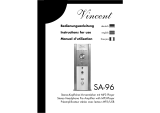
Vincent
31
OPERATING THE APPLIANCE
Operation Button(s) Description
Switch on and off
POWER (1)
The amplifier is switched on and off using this button at the front panel.
When switched off, the device is disconnected from the mains. As a precau-
tion, before switching on, the volume setting of the preamplifier should be
reduced. After switching on, the LED “POWER” on the front panel is blin-
king for about 30 seconds. In this time the tubes are being warmed up and
the loudspeakers are muted.
Activate or deactivate
each pair of connected
loudspeakers separately
SPEAKER A
SPEAKER B
(3)
For music playback at least one speaker pair must be connected (prefera-
bly at outputs “A”). The used outputs must be activated via the “SPEAKER”
buttons (3) (LED lights up). Activation of the second output (“B”) is only
necessary, if two speaker pairs are connected or one speaker pair in bi-
wiring.
Select an input
XLR/RCA (10)
Here you can select if the power amplifier is provided with the preamplifed
input signal at the XLR or the RCA connectors at the rear of the unit. If the
key is in its switched-on position, the SP-332 cannot process a signal con-
nected to the RCA connector, but expects the signal via the XLR connector.
It is allowed to use this switch even while music is being played back.
Burn in/ Warm up
Your audio components need a certain time
period until they reach maximum performance.
The duration of this “warm up“ time is very diffe-
rent for the various elements of your audio system.
Higher and homogeneous sound quality is achie-
ved while keeping the device switched on.
Your audio specialist dealer has enough experi-
ence to give you more information.
Net frequency noise
Some audio source devices may in combination
with the amplifier cause a humming noise at
power line frequency audible from your speakers.
Usually, its volume varies with the volume setting
of the amplifier. This is no sign of a defect or fault
of your audio products but has to be eliminated.
Generally, every wall-powered device connected
to the ground wire of the power plug can cause
this problem when connected to the amplifier.
Experience shows that this problem is mainly cau-
sed by antenna-connected components (as TV-sets
or Tuners), personal computers, electrostatic loud-
speakers, subwoofers, record players or headpho-
TIPS
ne amplifiers that are connected to the audio
inputs of the amplifier. Another possible reason
for humming noise is electromagnetic interference
of other components’ power supplies with pick-up-
systems of record players (change the place of the
record player for a test).
In most electric devices the ground potentials of all
signals are connected to each other at one central
point, where they have one common connection.
If the device uses the protective conductor of the
wall outlet, the corresponding wire of the line cord
is connected intractably to the metal housing of
the device. This is mostly the point where the cen-
tral grounding point is attached to. By doing this
the housing is able to shield all signals from exter-
nal radiated noise. Some main amplifiers are
equipped with a "Ground Lift" switch. If it is acti-
vated, ground potential of the chassis and the pro-
tective ground wire are being separated from the
central signal ground point. The protective ground
wire keeps its function. Sometimes this helps pre-
vent noise caused by errors in grounding.
If the problem occurs and cannot be solved by
yourself your audio specialist dealer will help you.




















